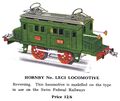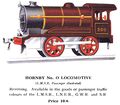Category:Hornby Series locomotives
| Hornby Series Loco | ||
|---|---|---|
Hornby Series locomotives | ||
| under development | ||
| Tin/M | 0-4-0 | 1920- |
| HT/No.1 | 0-4-0 | 1920 |
| No.2 | 4-4-0 | 1921 |
| ZuluT/No1T | 0-4-0 | 1922 |
| Zulu/No0 | 0-4-0 | 1923 |
| No.2T | 4-4-4 | 1923 |
| Metropolitan | 1925 | |
| Riv/No.3 | 4-4-2 | 1926 |
| No1Sp | 0-4-0 | 1929 |
| No.1SpT | 0-4-0 | 1929 |
| No.2Sp | 4-4-0 | 1929 |
| No.2SpT | 4-4-2 | 1929 |
| 4 Eton | 4-4-0 | 1937 |
| Princess | 4-6-2 | 1937 |
| "Hornby Trains" | ||
| (Post-War) | (0-4-0) | (-) |
Hornby : Hornby Clockwork Train | Tin-Printed Train | Zulu Trains | M Series | Hornby Series train sets | Hornby Series locomotives | Hornby Series rolling stock | Hornby Series accessories
Frank Hornby seems to have always wanted to make trains, but the first proper Hornby trains had to wait until after World War One (1914-18), when anti-German sentiment in Britain broke the hold that the German manufacturers had had on the market.
Hornby's initial trains appeared in 1920 - the enamelled "Hornby Clockwork Train", and the tinplate "Hornby Tin-Printed Train". The enamelled version took off, and spawned first the Zulu sets, and then the No1 locomotive line that continued in various guises until the 1950s (although not as Hornby Series). Descendants of the Tin Printed Train reappeared as a range of tinplate starter train sets, with sub-1 numbers, and as the M Series.
The range expanded through the 1920s, with the first electric Hornby train being the Metropolitan underground locomotive in 1925. The Riviera Blue appeared in 1926, and UK-liveried versions (the No3 loco range) joined it in 1927/28. The beloved No2 Specials showed up in 1929, after which the loco range stayed reasonably static (with minor revisions and electric versions) until the 1930s.
1937 saw the No4 Eton locomotive, and also the glorious Princess Elizabeth, with a 4-6-2 configuration that had previously been declared to be unachievable in gauge 0. The Princess Elizabeth was presented as a proper scale model, and was so obviously a one-off that it didn't need a number classification.
Post-1937
The Princess Elizabeth was followed by the introduction of the Hornby Dublo range in 1938, and then the disruptions of World War Two (1939-45) and the Korean War. When production started up again in earnest in 1958, it was clear that the company now needed to focus on the development of the smaller-scale Dublo range, and gauge 0 development tailed off, with the new Hornby Trains No501/50 pieces representing Hornby's final involvement in the format.
External links
Subcategories
This category has the following 14 subcategories, out of 14 total.
H
- Hornby M Series locomotives (4 P, 13 F)
- Hornby No 0 locomotives (4 P, 4 F)
- Hornby No1 locomotives (5 P, 11 F)
- Hornby No1 Special locomotives (3 P, 7 F)
- Hornby No2 locomotives (3 P, 8 F)
- Hornby No2 Special locomotives (7 P, 16 F)
- Hornby No3 locomotives (4 P, 13 F)
- Hornby No4 locomotives (2 P, 5 F)
- Hornby No501 locomotives (empty)
- Hornby Trains post-war (6 P, 2 F)
T
- Hornby No1 Tank locomotives (7 P, 14 F)
- Hornby No1 Special Tank locomotives (3 P, 7 F)
- Hornby No2 Tank locomotives (6 P, 9 F)
- Hornby No2 Special Tank locomotives (5 P, 8 F)
Pages in category ‘Hornby Series locomotives’
The following 54 pages are in this category, out of 54 total.
F
G
L
- LMS locomotive 6161 (Hornby Series)
- LNWR locomotive 3435 (Hornby Series)
- Loco Southern 29, No1 Electric Tank Loco (Hornby Series)
- Loco Southern 29, No1 Tank Loco (Hornby Series)
- Locomotive GW 2221, No2 Special Tank (Hornby Series)
- Locomotive GW 2711, No2 (Hornby Series)
- Locomotive LMS 0-4-0, No1 Tank Loco (Hornby Series)
- Locomotive LMS 1185 (Hornby Series E220)
- Locomotive LMS 2051, Tank Loco No2 (Hornby Series)
- Locomotive LMS 8712, No1 Special (Hornby Series)
- Locomotive LNER 0-4-0, No1 Tank Loco (Hornby Series)
- Locomotive LNER 2162, No1 Special (Hornby Series)
- Locomotive LNER 2900, Tank Loco No1 (Hornby Series)
- Locomotive LNER 460, Tank Loco No2 (Hornby Series)
- Locomotive No2 Special, LMS 1185 (Hornby Series)
- Locomotive Southern 1759, No.2 Special (Hornby Series)
- Locomotive Southern B 602,Tank Loco No2 (Hornby Series)
- Locomotive Southern B 604,Tank Loco No2 (Hornby Series)
- Lord Nelson loco 850, No3 (Hornby Series)
M
N
- No 0 locomotive 2710 (Hornby Series)
- No 0 Locomotive 4797 (Hornby Series)
- No. 1 Special Tank Locomotive 70 (Hornby Series)
- No1 Special Electric Tank Locomotive, Southern 516 (Hornby Series E120 )
- No1 Special Locomotive, electric, Southern 1179 (Hornby Series E120)
- No2 Tank Loco LMS 2052 (Hornby Series)
- No3 Passenger Train Set, box only (Hornby Series)
P
T
- Tank Locomotive 2180, No2 Special (Hornby Series)
- Tank Locomotive 463, boxed (Hornby No1 Electric)
- Tank locomotive 492 (Hornby No.2 Special Tank Locomotive)
- The Hornby Clockwork Loco No2, LNER 1534 (Hornby Series)
- The Hornby Clockwork Train (Hornby, 1920)
- The Hornby Clockwork Train, No1 Loco and Tender, box (Hornby Series)
- The Hornby Trains prototype
- Tin Printed Clockwork Train (Meccano Ltd, 1920)
Media in category ‘Hornby Series locomotives’
The following 80 files are in this category, out of 80 total.
- Colouring-in sheet - M-Series Locomotive.jpg 3,508 × 2,482; 830 KB
- Eton 900 locomotive detail, Hornby.jpg 800 × 600; 381 KB
- Eton locomotive 900 (MM 1937-08).jpg 1,583 × 729; 286 KB
- Eton locomotive 900 article (MM 1937-08).jpg 2,438 × 3,458; 1.4 MB
- French Hornby, gauge 0, selection.jpg 2,133 × 1,600; 505 KB
- George the Fifth loco 2663 (Meccano Ltd).jpg 1,024 × 639; 80 KB
- HBOT 1938-39 p15 Princess Elizabeth model.jpg 1,638 × 1,235; 575 KB
- Hornby 3C GWR Cornish Riviera box end (~1927).jpg 720 × 356; 128 KB
- Hornby and Zulu Trains (MM 1924-03).jpg 1,605 × 2,114; 453 KB
- Hornby Clockwork Train, detail.jpg 1,024 × 768; 500 KB
- Hornby E120 Special Passenger Train (1939- catalogue).jpg 2,371 × 753; 502 KB
- Hornby E220 Electric Tank Goods Train (1939- catalogue).jpg 2,365 × 713; 387 KB
- Hornby E220 Special Locomotive, LMS 1185 (HBoT 1934).jpg 1,961 × 1,477; 402 KB
- Hornby E36 Metropolitan Locomotive (HBoT 1934).jpg 2,127 × 1,225; 375 KB
- Hornby E420 Eton Locomotive (1939- catalogue).jpg 2,269 × 999; 278 KB
- Hornby LE120 Locomotive, Swiss (HBoT 1934).jpg 1,945 × 1,301; 298 KB
- Hornby LEC1 Locomotive, Swiss (HBoT 1934).jpg 2,063 × 1,735; 366 KB
- Hornby Metropolitan locomotive 110-Volt, detail.jpg 800 × 600; 219 KB
- Hornby Metropolitan Train Set (HBoT 1930).jpg 3,106 × 975; 465 KB
- Hornby No.0 Passenger Set, LNER (1925 HBoT).jpg 2,000 × 800; 352 KB
- Hornby No.1 Tank Loco, LMS (1925 HBoT).jpg 950 × 750; 105 KB
- Hornby No.1 Tank Loco, LMS Goods (1925 HBoT).jpg 950 × 750; 105 KB
- Hornby No.1 Tank Loco, LNER (1925 HBoT).jpg 950 × 750; 103 KB
- Hornby No.1 Tank Locomotive, LMS 2115 (HBoT 1931).jpg 1,385 × 985; 212 KB
- Hornby No.2 Tank Loco, LMS (1925 HBoT).jpg 1,450 × 800; 160 KB
- Hornby No.2 Tank Loco, LMS Goods (1925 HBoT).jpg 1,450 × 800; 173 KB
- Hornby No.2 Tank Loco, LNER (1925 HBoT).jpg 1,450 × 800; 146 KB
- Hornby No0 Locomotive LMS 8324 (HBoT 1930).jpg 1,568 × 803; 168 KB
- Hornby No0 Locomotive, LMS 500 (HBoT 1934).jpg 2,085 × 1,821; 368 KB
- Hornby No0 Locomotive, Southern 509 (HBoT 1930).jpg 1,538 × 831; 200 KB
- Hornby No1 Electric Tank Locomotive LMS 623 (HBoT 1929).jpg 2,673 × 1,929; 602 KB
- Hornby No1 Locomotive GW 2449 (HBoT 1930).jpg 962 × 496; 89 KB
- Hornby No1 Locomotive LNER 5097 (HBoT 1930).jpg 1,031 × 527; 93 KB
- Hornby No1 Special Locomotive and Tender LMS 4312 (HBoT 1929).jpg 1,701 × 1,133; 256 KB
- Hornby No1 Special Locomotive, LMS 4525 (HBoT 1930).jpg 1,529 × 747; 163 KB
- Hornby No1 Special Locomotive, Southern A 179 (HBoT 1930).jpg 1,391 × 701; 157 KB
- Hornby No1 Special Tank Locomotive LMS 6418 (HBoT 1929).jpg 1,461 × 907; 201 KB
- Hornby No1 Special Tank Locomotive SOUTHERN A 950 (HBoT 1929).jpg 1,491 × 913; 222 KB
- Hornby No1 Tank Loco (MC 1925).jpg 787 × 1,077; 97 KB
- Hornby No1 Tank Loco, GW Goods or Passenger (1926 HBoT).jpg 972 × 710; 122 KB
- Hornby No1 Tank Locomotive GW (HBoT 1929).jpg 1,373 × 955; 207 KB
- Hornby No1 Tank Locomotive LMS 623 (HBoT 1929).jpg 1,373 × 941; 199 KB
- Hornby No1 Tank Locomotive, SR Passenger 667 (HBoT 1928).jpg 1,507 × 1,020; 255 KB
- Hornby No2 Special Electric Tank Locomotive GW 2221 (HBoT 1930).jpg 1,481 × 966; 264 KB
- Hornby No2 Special Locomotive and Tender LNER 234 Yorkshire (HBoT 1929).jpg 1,419 × 471; 128 KB
- Hornby No2 Special Locomotive GWR 3821 County of Bedford (HBoT 1938).jpg 1,553 × 970; 195 KB
- Hornby No2 Special locomotive, GWR 3821 County of Bedford, detail.jpg 1,024 × 768; 408 KB
- Hornby No2 Special locomotive, LMS 1185 (HBoT 1938).jpg 1,586 × 1,094; 172 KB
- Hornby No2 Special Locomotive, LMS 1185, detail.jpg 1,024 × 574; 399 KB
- Hornby No2 Special Locomotive, LNER 234 Yorkshire, detail.jpg 1,024 × 768; 378 KB
- Hornby No2 Special locomotive, SR 1759 (HBoT 1938).jpg 1,397 × 1,187; 185 KB
- Hornby No2 Special locomotives (HBoT 1938).jpg 3,276 × 2,500; 1.15 MB
- Hornby No2 Special Passenger Locomotive and Tender GW 3821 (HBoT 1929).jpg 1,946 × 1,334; 344 KB
- Hornby No2 Special Pullman Sets (HBoT 1929).jpg 2,124 × 973; 356 KB
- Hornby No2 Special Tank Locomotive LNER 6 (HBoT 1929).jpg 3,156 × 2,241; 759 KB
- Hornby No2 Tank Loco (MC 1925).jpg 877 × 1,077; 112 KB
- Hornby No2 Tank Locomotive, GW 4202 (HBoT 1928).jpg 1,466 × 740; 168 KB
- Hornby No2 Tank Locomotive, SR Passenger B 604 (HBoT 1928).jpg 1,463 × 779; 202 KB
- Hornby No3 Locomotive LMS 6100 Royal Scot (HBoT 1930).jpg 2,702 × 986; 336 KB
- Hornby No3 Locomotive Southern 850 Lord Nelson (HBoT 1930).jpg 2,756 × 917; 347 KB
- Hornby Princess Elizabeth (1939- catalogue).jpg 2,292 × 982; 353 KB
- Hornby Princess Elizabeth (MM1937-09).jpg 1,605 × 2,146; 626 KB
- Hornby Princess Elizabeth 6201 locomotive detail.jpg 1,024 × 768; 384 KB
- Hornby Princess Elizabeth locomotive 6201 (1939 catalogue).jpg 2,464 × 1,592; 601 KB
- Hornby Train Running Day.jpg 1,024 × 575; 429 KB
- Hornby Trains Princess Elizabeth 6201 (MM 1938-11).jpg 2,310 × 1,455; 574 KB
- Hornby Trains, A Perfect Miniature Railway (1931 HBoT).jpg 3,270 × 2,408; 953 KB
- Hornby Trains, a perfect miniature railway (MM 1935-08).jpg 1,695 × 2,200; 684 KB
- Hornby Trains, original Meccano prototype.jpg 640 × 680; 138 KB
- Locomotive SR 1759, Hornby No2 Special (1930s layout).jpg 1,600 × 1,200; 1.35 MB
- Princess Elizabeth 6201 ad (Meccano No 9-10 manual).jpg 2,438 × 1,487; 865 KB
- Scarborough Flyer - Bramham Moor (HBoT 1938).jpg 3,283 × 2,484; 1.13 MB
- Southern 900 Eton locomotive (HBoT 1938).jpg 3,286 × 2,476; 1.04 MB
- The Hornby Clockwork Train No.1 (embossed box lid).jpg 800 × 426; 237 KB
- The Hornby Clockwork Train, open box.jpg 592 × 685; 72 KB
- The Hornby Clockwork Train.jpg 1,189 × 1,440; 236 KB
- The Hornby Electric Train (MM 1925-12).jpg 1,166 × 1,600; 355 KB
- The Hornby Railway Company (HBoT 1932).jpg 2,036 × 1,484; 582 KB
- Three New Hornby Trains, Hornby No.3 locomotives (MM 1927-12).jpg 929 × 1,200; 527 KB
- Tin Printed Clockwork Trains (Meccano Ltd, 1920).jpg 1,179 × 954; 125 KB











































































